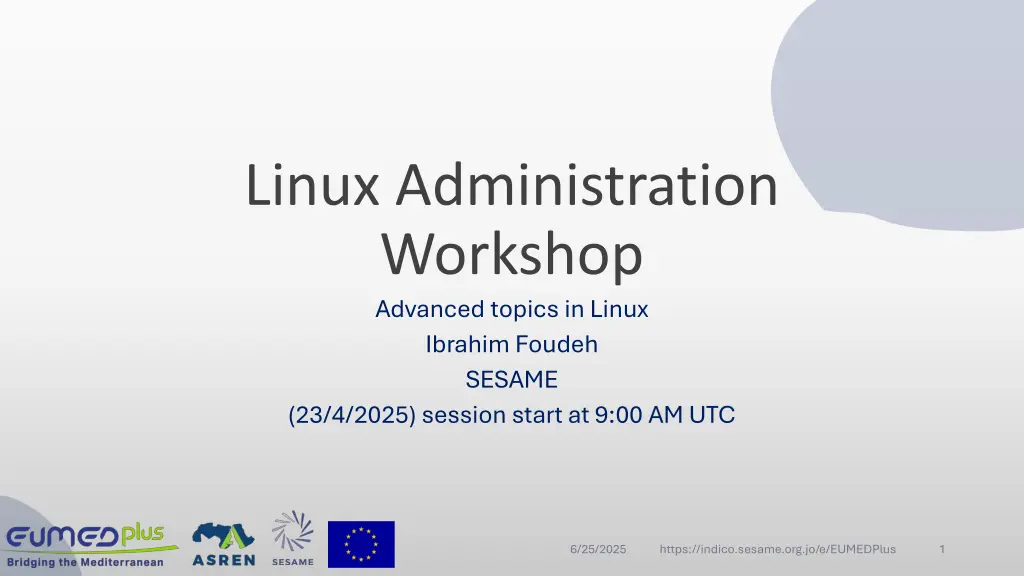
Advanced Linux Administration Workshop Insights
Enhance your Linux system administration skills with a workshop covering topics like system services, filtering tools, Samba file-sharing, Ansible automation, and more. Learn practical steps on configuring SAMBA mounts, adjusting firewalls, and securing Samba share directories. Explore the agenda and objectives for a comprehensive learning experience.
Download Presentation

Please find below an Image/Link to download the presentation.
The content on the website is provided AS IS for your information and personal use only. It may not be sold, licensed, or shared on other websites without obtaining consent from the author. If you encounter any issues during the download, it is possible that the publisher has removed the file from their server.
You are allowed to download the files provided on this website for personal or commercial use, subject to the condition that they are used lawfully. All files are the property of their respective owners.
The content on the website is provided AS IS for your information and personal use only. It may not be sold, licensed, or shared on other websites without obtaining consent from the author.
E N D
Presentation Transcript
Linux Administration Workshop Advanced topics in Linux Ibrahim Foudeh SESAME (23/4/2025) session start at 9:00 AM UTC 6/25/2025 https://indico.sesame.org.jo/e/EUMEDPlus 1
Workshop Objectives Understand system services Learn about filtering and redirection tools Share files across OS s with Samba . Set up ansible server for automation. 6/25/2025 https://indico.sesame.org.jo/e/EUMEDPlus 2
Agenda 1.System Monitoring 2.Log Analysis 3.Redirection & Filtering 4.Process Management 5.PXE Server Basics 6.Ansible Automation 7.Q&A 6/25/2025 https://indico.sesame.org.jo/e/EUMEDPlus 3
How to configure SAMBA Mount Step 1 Downloading and Installing the Components dnf install samba samba-common samba-client Step 2 Creating the Share Directories on the Host and assign permission sudo mkdir /var/nfs/school2 p sudo chmod -R 755 /var/nfs/school2 sudo chown -R nobody:nobody /var/nfs/school2 6/25/2025 https://indico.sesame.org.jo/e/EUMEDPlus 4
How to configure SAMBA Mount Step 3 Configuring the smb.conf on the Host Server and test the parameter sudo vim /etc/samba/smb.conf directory_to_share client(share_option1,...,share_optionN) [Public] path = /var/nfs/school2 browsable =yes writable = yes guest ok = yes read only = no sudo testparm 6/25/2025 https://indico.sesame.org.jo/e/EUMEDPlus 5
How to configure SAMBA Mount Step 4 Adjusting the Firewall on the Host firewall-cmd --permanent --list-all | grep services sudo firewall-cmd --permanent --add-service=samba sudo firewall-cmd --reload sudo firewall-cmd --list-services 6/25/2025 https://indico.sesame.org.jo/e/EUMEDPlus 6
How to configure SAMBA Mount Step 5 Accessing Samba Share from Windows \\server-ip 6/25/2025 https://indico.sesame.org.jo/e/EUMEDPlus 7
How to configure SAMBA Mount Step 6 Secure Samba Share Directory useradd smbuser smbpasswd -a smbuser sudo groupadd smb_group sudo usermod -g smb_group smbuser sudo vim /etc/samba/smb.conf [Puplic] path = /mnt/test1 valid users = @smb_group guest ok = no writable = no browsable = yes sudo systemctl restart smb sudo systemctl restart nmb 6/25/2025 https://indico.sesame.org.jo/e/EUMEDPlus 8
Processes management What is the Process ? Processes carry out tasks within the operating system. A program is a set of machine code instructions and data stored in an executable image on disk and is, as such, a passive entity; a process can be thought of as a computer program in action. 6/25/2025 https://indico.sesame.org.jo/e/EUMEDPlus 9
Processes management Types of processes The user process: - is started from a terminal associated with a user - accesses resources via requests or daemon The system process (daemon): - is started by the system - is not associated with any terminal and is owned by a system user (often root) - is loaded at boot time, resides in memory, and is waiting for a call -is usually identified by the letter d associated with the process name 6/25/2025 https://indico.sesame.org.jo/e/EUMEDPlus 10
Process management controls kill command the kill command sends a stop signal to a process kill [-signal] PID Signals are the means of communication between processes. The kill command sends a signal to a process. 6/25/2025 https://indico.sesame.org.jo/e/EUMEDPlus 11
Process management controls fg and bg commands The fg command puts the process in the foreground, while the command bg places it in the background: jobs command Signals are the means of communication between processes. The kill command sends a signal to a process. jobs l fg %2 # Resume interacting with the second sleep command ^Z # Suspend it bg %2 # Resume in the background sleep 200 & sleep 300 ^Z # Suspend the second sleep command 6/25/2025 https://indico.sesame.org.jo/e/EUMEDPlus 12
System monitoring tools Live Monitoring: Command Command Purpose Purpose Top/htop Ps Vmstat Vmstat 1 1 process viewer Running process viewer Virtual memory stats every 1s Disk Usage Analysis Command Command Purpose Purpose df -h Disk free space du -sh Directory size iostat I/O statistics 6/25/2025 https://indico.sesame.org.jo/e/EUMEDPlus 13
Manage services with systemctl Systemd Systemd is a Systems and Services Administrator for Linux is a Systems and Services Administrator for Linux- -based Systems. But, more broadly, it can also be described as a set of basic building blocks for a Linux more broadly, it can also be described as a set of basic building blocks for a Linux System, as it provides a Systems and Services Administrator which runs as a System, as it provides a Systems and Services Administrator which runs as a process (PID 1) and starts the rest of the system. process (PID 1) and starts the rest of the system. systemctl systemctl command, which is the central management tool for controlling the Init system (Systems and services administrator initial of Unix systems). based Systems. But, 6/25/2025 https://indico.sesame.org.jo/e/EUMEDPlus 14
Manage services with systemctl 6/25/2025 https://indico.sesame.org.jo/e/EUMEDPlus 15
Log Management with journalctl What is the use of Journalctl command? Journalctl is a utility for querying and displaying logs from journald, systemd's logging service. Important logs files to check /var/log/syslog: General system logs. /var/log/auth.log: SSH/Sudo attempts. /var/log/kern.log: Kernel events. 6/25/2025 https://indico.sesame.org.jo/e/EUMEDPlus 16
Finding tool Purpose Search ScopeSpeed Database Usage Search Criteria Output Command Examples Find files/directori es by name quickly. Pre-built database (entire FS) Very fast Yes (updatedb)Filename Full paths of matching entries locate locate *.log patterns (basic regex support) Search files/directori es in real-time with advanced filters. Specified directory subtree Slow No (live search) Name, size, time, permissions, type, etc. Full paths of matching entries (customizable) find find /home -name "*.txt" - mtime -7 Locate the path of an executable in $PATH. Directories in $PATH Instant No Exact executable name First matching executable path which which python 6/25/2025 https://indico.sesame.org.jo/e/EUMEDPlus 17
Redirection Operators Description Common Options/Usage Examples Tool/Operator Redirect stdout to a file (overwrite). command > file ls > output.txt > Redirect stdout to a file (append). command >> file echo "new line" >> log.txt >> Redirect stdin from a file. command < file sort < unsorted.txt < command 2> error.loggrep "error" logs.txt 2> errors.log Redirect stderr to a file. 2> command &> combined.log python script.py &> output.log Redirect stdout + stderr to a file. &> Pipe stdout to another command. command1 | command2 cat file.txt | grep "warning" | 6/25/2025 https://indico.sesame.org.jo/e/EUMEDPlus 18
6/25/2025 https://indico.sesame.org.jo/e/EUMEDPlus 19
Filtering & Text Processing Tools Description Common Options/Usage Examples Tool/Operator -i (case-insensitive) -v (invert match) -n (line numbers) grep -i "error" /var/log/syslog ps aux | grep "nginx" grep Search for patterns in text. -F (field separator) {print $N} awk -F: '{print $1}' /etc/passwd df | awk '$4 > 90 {print $1}' awk Pattern scanning and text processing. s/old/new/g (replace) -i (in-place) sed 's/foo/bar/g' file.txt sed -i '/^#/d' config.conf (delete comments) sed Stream editor (text substitution). -d (delimiter) -f (fields) cut Extract columns from text. cut -d: -f1,3 /etc/passwd -r (reverse) -n (numeric sort) sort -nr data.txt du -sh * | sort -h sort Sort lines of text. -c (count occurrences) -d (show duplicates) uniq Remove duplicate lines. sort file.txt | uniq -c tee Split output to a file and stdout. -a (append) ls -l | tee dir_list.txt 6/25/2025 https://indico.sesame.org.jo/e/EUMEDPlus 20
Filtering & Text Processing Tools Description Common Options/Usage Examples Tool/Operator echo "HELLO" | tr 'A-Z' 'a-z' cat file.txt | tr -d '\r' tr Translate or delete characters. -d (delete) head Display the first N lines of a file. -n 10 (show 10 lines) head -n 5 /var/log/syslog -n 10 -f (follow in real-time) tail Display the last N lines of a file. tail -f /var/log/nginx/access.log find . -name "*.log" | xargs rm ls *.txt | xargs -I{} cp {} backup/ xargs Build commands from stdin. -I{} (replace string) Find -name (name pattern) -exec (run command) find /var/log -name "*.log" find . -type f -exec chmod 644 {} \; Search for files/directories. 6/25/2025 https://indico.sesame.org.jo/e/EUMEDPlus 21
Automation with Ansible What is Ansible? Agentless Automation: Manages systems over SSH (no client installation required). Idempotent: Ensures consistent state regardless of current system status. YAML Playbooks: Declarative configuration files for defining tasks. Why Ansible on Rocky Linux? Simplify server provisioning, configuration, and application deployment. Integrates seamlessly with RHEL-based systems (uses dnf modules). Minimal setup: Requires only Python and SSH access. 6/25/2025 https://indico.sesame.org.jo/e/EUMEDPlus 22
Ansible Playbook Example Step 1: Install Ansible sudo dnf install epel-release -y sudo dnf install ansible -y Step 2: Create Inventory File # ~/inventory.ini [web_servers] rocky-server1 ansible_host=192.168.1.100 6/25/2025 https://indico.sesame.org.jo/e/EUMEDPlus 23
Ansible Playbook Example Step 3: Write a Playbook (deploy_apache.yml): --- - name: Install and Start Apache hosts: web_servers become: yes # Run as root tasks: - name: Install Apache dnf: name: httpd state: present - name: Start and Enable Apache service: name: httpd state: started enabled: yes - name: Ensure port 80 is open firewalld: port: 80/tcp permanent: yes state: enabled notify: reload firewall handlers: - name: reload firewall command: firewall-cmd --reload 6/25/2025 https://indico.sesame.org.jo/e/EUMEDPlus 24
Ansible Playbook Example Step 4: Run the Playbook ansible-playbook -i inventory.ini deploy_apache.yml This example demonstrates installing Apache, configuring the firewall, and ensuring idempotency. Adjust IPs and users for your lab! 6/25/2025 https://indico.sesame.org.jo/e/EUMEDPlus 25
PXE server 6/25/2025 https://indico.sesame.org.jo/e/EUMEDPlus 26
PXE server 6/25/2025 https://indico.sesame.org.jo/e/EUMEDPlus 27
Questions? 6/25/2025 https://indico.sesame.org.jo/e/EUMEDPlus 28
Thank You 6/25/2025 https://indico.sesame.org.jo/e/EUMEDPlus 29






















